Definition: The “Internet Peering Ecosystem” is a community of loosely affiliated network service providers that interact and interconnect their networks in various business relationships.
Definition: An Internet Region is a portion of the Internet, usually defined by geographical boundaries (country or continent borders), in which an Internet Peering ecosystem is contained.
Definition: The Peering Break Even Point is the point where the unit cost of peering exactly equals the unit cost for transit.
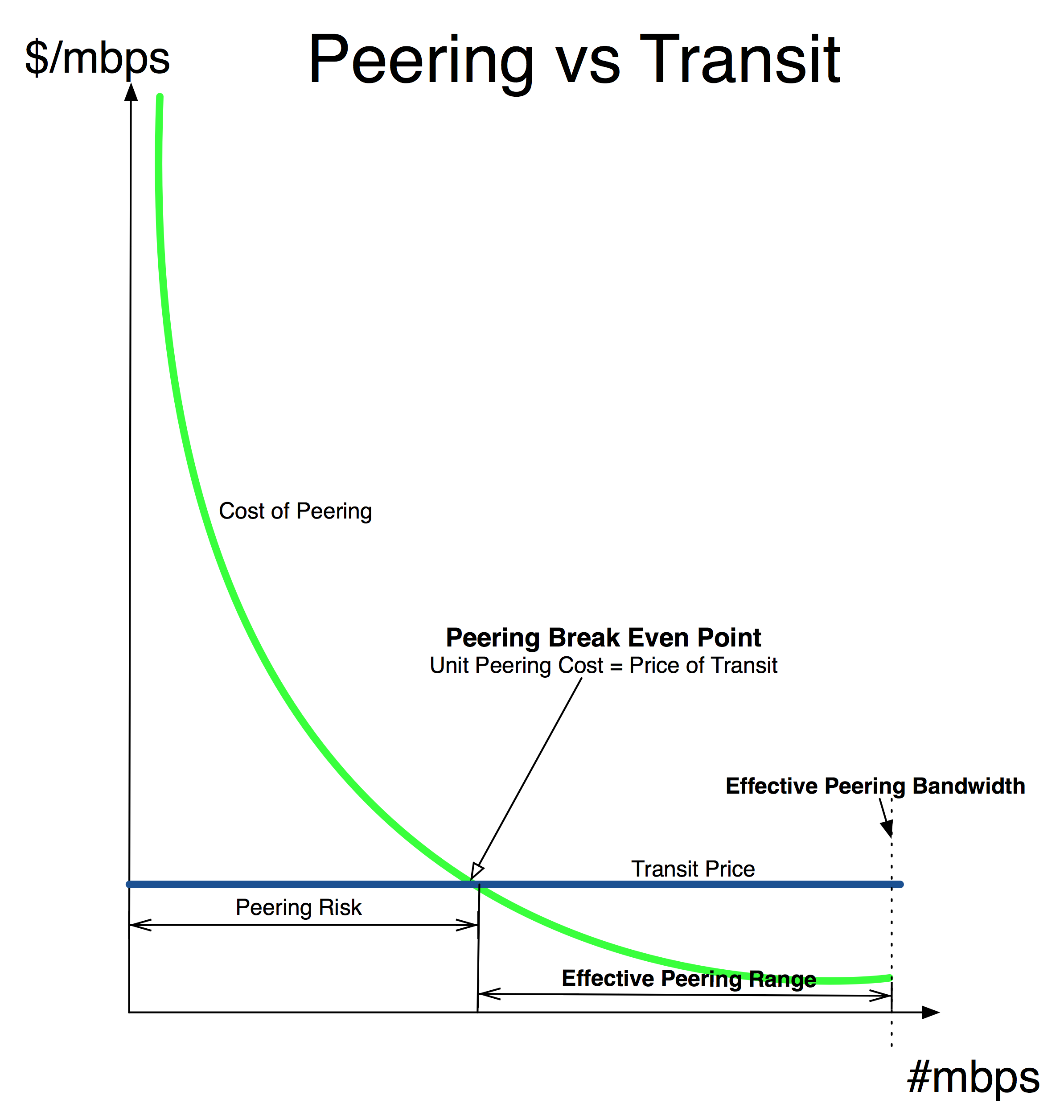
Definition: A Peering Inclination is a predisposition towards or against peering as demonstrated by Peering behavior in an Internet Peering Ecosystem.
Definition: Internet Service Providers (ISPs) connect end-users and businesses to the public Internet.
Definition: An Internet (IX) is a layer 2 service to facilitate the interconnection between Internet Service Providers and Large Scale Network Savvy Content Providers.
Definition: Internet Transit is the business relationship whereby one ISP provides (usually sells) access to all destinations in its routing table .

Figure - Transit Relationship - selling access to the entire Internet.
Internet Transit can be thought of as a pipe in the wall that says "Internet this way".
In the illustration above, the Cyan ISP purchases transit from the Orange Transit Provider (sometimes called the "Upstream ISP"), who announces to the Cyan ISP reachability to the entire Internet (shown as many colored networks to the right of the Transit Providers). At the same time, the Transit Provider propagates the Cyan routes across the Internet so that all attached networks know to send packets to the Cyan ISP through the Orange Transit Provider. In this way, all Internet attachments know how to reach the Cyan ISP, and the Cyan ISP knows how to get to all the Internet routes.
Some Characteristics of Internet Transit
Transit is a simple service from the customer perspective. All one needs to do is pay for the Internet Transit service and all traffic sent to the upstream ISP is delivered to the Internet. The transit provider charges on a metered basis, measured on a per-Megabit-per-second basis using the 95th percentile measurement method.
Transit provides a Customer-Supplier Relationship. Some content providers shared with the author that they prefer a transit service (paying customer) relationship with ISPs for business reasons as well. They argue that they will get better service with a paid relationship than with any free or bartered relationship. They believe that the threat of lost revenue is greater than the threat of terminating a peering arrangement if performance of the interconnection is inadequate.
Transit may have SLAs. Service Level Agreement and rigorous contracts with financial penalties for failure to meet service levels may feel comforting but are widely dismissed by the ISPs that we spoke with as merely insurance policies. The ISPs said that it is common practice to simply price the service higher with SLAs, with increased pricing proportional to the liklihood of their failure to meet these requirements. Then the customer has to notice, file for the SLA credits, and check to see that they are indeed applied. There are many ways for SLAs to simply increase margins for the ISPs without needing to improve the service.
Transit Commits and Discounts. Upstream ISPs often provide volume discounts based on negotiated commit levels. Thus, if you commit to 10Gigabits-per-second of transit per month, you will likely get a better unit price than if you commit to only 1gigabit-per-second of transit per month. However, you are on the hook for (at least) the commit level worth of transit regardless of how much traffic you send.
Transit is a commodity. There is debate within the community on the differences between transit from a low cost provider and the Internet transit service delivered from a higher priced provider. The higher price providers argure that they have better quality equipment (routers vs. switches)
Transit is a metered Service. The more you send or receive, the more you pay. (There are other models such as all-you-can-eat, flat monthly rate plans, unmetered with bandwidth caps, etc. but at the scale of networking where Internet Peering makes sense the Internet Transit services are metered.)
Definition: Internet Peering is the business relationship whereby companies reciprocally provide access to each others’ customers.
This definition applies equally to Internet Service Providers (ISPs), Content Distribution Networks (CDNs), and Large Scale Network Savvy Content Providers.
To illustrate peering, considerthe figure below showing a much simplified Internet; an Internet with only three ISPs: WestNet, MidNet, and EastNet.
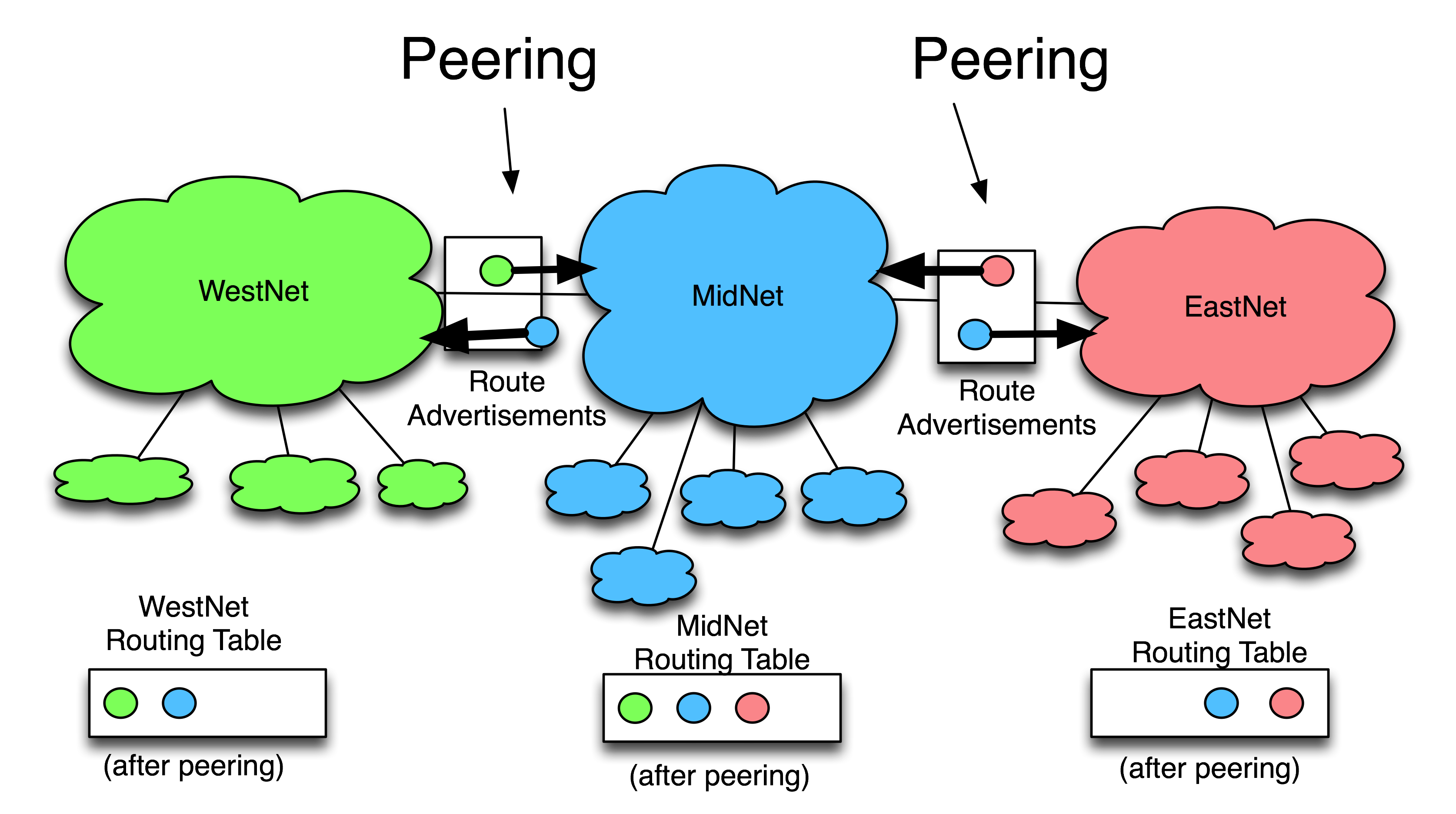
WestNet is an ISP with green customers, MidNet is an ISP with blue customers, and EastNet is an ISP with red customers.
WestNet is in a Peering relationship with MidNet whereby WestNet learns how to reach MidNet's blue customers, and MidNet reciprocally learns how to reach WestNet's green customers.
EastNet is in a Peering relationship with MidNet whereby EastNet learns how to reach MidNet's blue customers, and MidNet reciprocally learns how to reach EastNet's red customers.
Peering is typically a free arrangement, with each side deriving about the same value from the reciprocally arrangement. If there is not equal value, sometime one party of the other pushes for a Paid Peering relationship.
Important as well is that peering is not a transitive relationship. WestNet peering with MidNet and EastNet peering with MidNet does not mean EastNet customers can reach WestNet customers. WestNet only knows how to get to blue and green customers, and EastNet knows how to reach only blue and red customers. The fact that they both peer with MidNet is inconsequential; peering is a non-transitive relationship.
Definition: A Regional Tier 1 ISP is an ISP that has access to the entire Internet Region routing table solely through Peering relationships.

The figure above models a Tier 1 ISP graphically as selling transit to downstream customers, peering traffic away off to the side, and operating backbone links to offload the traffic elsewhere in their network.
Through these free peering connections, the Tier 1 ISPs all enjoy settlement-free access to all destinations within the Internet Region. Some in the Peering Community refer to the set of Tier 1 ISPs as the "The Tier 1 club". The Tier 1 ISPs sell access to the region as part of a transit service as well, often as a wholesale transit service, to Tier 2 ISPs, CDNs, and Large Scale Network Savvy Content Providers.
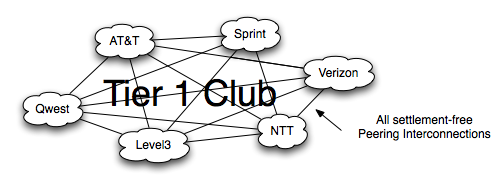
While this "Tier 1 ISP" definition has been criticized as being almost impossible to prove it is an important distinction as it pertains to ISP motivations and behaviors in the Internet Region. Tier 1 ISPs are not motivated to peer to reduce the cost of transit since, by definition, Tier 1 ISPs don’t pay for transit.
Tier 1 ISPs may peer in many geographically diverse locations for technical reasons. Peering has the benefit of lower latency, better control over routing, and may therefore lead to lower packet loss. For ISPs that charge on a per-Mbps basis, this leads to financial benefits as customers use more bandwidth and therefore pay more money. This is a function of TCP: lower latency and lower packet loss means that the TCP window opens more quickly. This results in greater usage and therefore greater customer revenue. Most Tier 1 ISPs around the world exchange enough traffic with each other to require multiple points of interconnect.
A Tier 1 Peering Policy generally includes a minimum number of locations as a requirement for peering.
Tier 1 ISPs do not need to buy transit since by definition they can reach all the networks in the Internet Peering Ecosystem solely through free peering relationships. Stated most eloquently by Waqar Khan (Qwest, a Tier 1 ISP in the U.S.), “We have all the peering we need.” It is not surprising that Tier 1 ISPs see the rest of the players in the Internet Peering Ecosystem players as potential customers, and do not seek peering with them. In fact, James Spenceley (Comindico) went through the process of negotiating peering with the Tier 1 ISPs in Australia and described the Tier 1 peering negotiation tactics in a one word acronym: MILD: Make It Long and Difficult . This reflects the ISP’s underlying Peering Inclination, perhaps articulated in their Peering Policy .
Definition: A Tier 2 ISP is an Internet Service Provider that purchases (and therefore resells) transit within an Internet Region.

The figure above models a Tier 2 ISP graphically position as purchasing transit from an upstream provider, selling transit to downstream customers, peering traffic away off to the side, and operating (optional) backbone links to offload the traffic elsewhere in their network.
A Tier 2 ISP will often embrace peering to reduce transit costs, improve performance, and potentially even increase revenue. You will find Tier 2 ISPs participating actively in Peering Forums - this is an expected bahavior from a player looking to increase the amount of peering they have. Some of the larger Tier 2 ISPs will be able to peer away towards 70% of their traffic.
Definition: Internet Transit is the business relationship whereby one ISP provides (usually sells) access to all destinations in its routing table .

Figure - Transit Relationship - selling access to the entire Internet.
Internet Transit can be thought of as a pipe in the wall that says "Internet this way".
In the illustration above, the Cyan ISP purchases transit from the Orange Transit Provider (sometimes called the "Upstream ISP"), who announces to the Cyan ISP reachability to the entire Internet (shown as many colored networks to the right of the Transit Providers). At the same time, the Transit Provider propagates the Cyan routes across the Internet so that all attached networks know to send packets to the Cyan ISP through the Orange Transit Provider. In this way, all Internet attachments know how to reach the Cyan ISP, and the Cyan ISP knows how to get to all the Internet routes.
Some Characteristics of Internet Transit
Transit is a simple service from the customer perspective. All one needs to do is pay for the Internet Transit service and all traffic sent to the upstream ISP is delivered to the Internet. The transit provider charges on a metered basis, measured on a per-Megabit-per-second basis using the 95th percentile measurement method.
Transit provides a Customer-Supplier Relationship. Some content providers shared with the author that they prefer a transit service (paying customer) relationship with ISPs for business reasons as well. They argue that they will get better service with a paid relationship than with any free or bartered relationship. They believe that the threat of lost revenue is greater than the threat of terminating a peering arrangement if performance of the interconnection is inadequate.
Transit may have SLAs. Service Level Agreement and rigorous contracts with financial penalties for failure to meet service levels may feel comforting but are widely dismissed by the ISPs that we spoke with as merely insurance policies. The ISPs said that it is common practice to simply price the service higher with SLAs, with increased pricing proportional to the liklihood of their failure to meet these requirements. Then the customer has to notice, file for the SLA credits, and check to see that they are indeed applied. There are many ways for SLAs to simply increase margins for the ISPs without needing to improve the service.
Transit Commits and Discounts. Upstream ISPs often provide volume discounts based on negotiated commit levels. Thus, if you commit to 10Gigabits-per-second of transit per month, you will likely get a better unit price than if you commit to only 1gigabit-per-second of transit per month. However, you are on the hook for (at least) the commit level worth of transit regardless of how much traffic you send.
Transit is a commodity. There is debate within the community on the differences between transit from a low cost provider and the Internet transit service delivered from a higher priced provider. The higher price providers argure that they have better quality equipment (routers vs. switches)
Transit is a metered Service. The more you send or receive, the more you pay. (There are other models such as all-you-can-eat, flat monthly rate plans, unmetered with bandwidth caps, etc. but at the scale of networking where Internet Peering makes sense the Internet Transit services are metered.)
Definition: Content Distribution Networks (CDNs) are companies that operate an Internet Service to distribute objects as close to the end users as possible, often to the edge or embedded within the Access Network.
Definition: Large Scale Network Savvy Content Providers are companies that do not sell transit but operate a large scale network and engage in peering in support of internal customers.
The model for the Network Savvy Large Scale Content Provider is shown in the figure below.
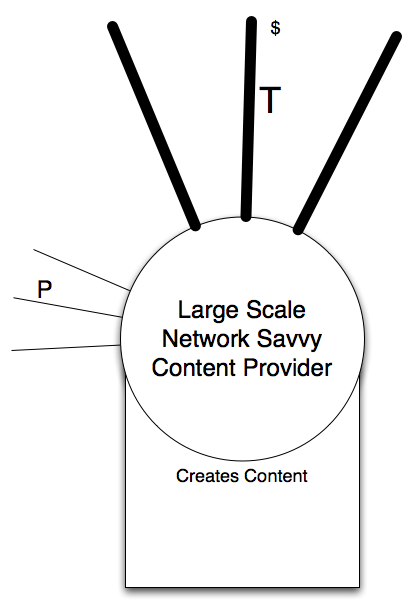
The links to the side represent the Internet Peering interconnects while the links to the top represent the upstream Internet Transit links.
Definition:
Content Providers are all companies that operate an Internet Service but do not sell transit within the Internet Peering Ecosystem.
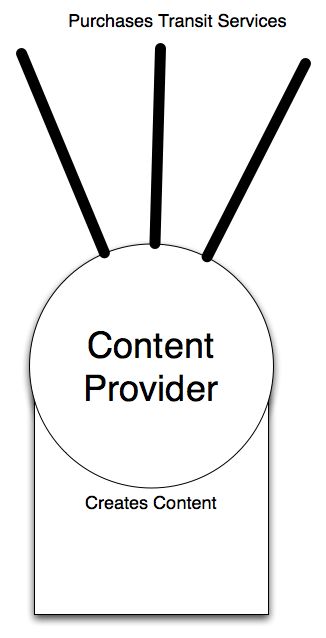
The model above shows this player simply purchasing transit from an upstream provider while creating content as their core business.
Definition: A No-Peering Policy is an articulation of an inclination not to peer at all.Definition: An Open Peering Policy is an articulation of an inclination to peer with anyone.
Definition: Internet Peering is the business relationship whereby companies reciprocally provide access to each others’ customers.
This definition applies equally to Internet Service Providers (ISPs), Content Distribution Networks (CDNs), and Large Scale Network Savvy Content Providers.
To illustrate peering, considerthe figure below showing a much simplified Internet; an Internet with only three ISPs: WestNet, MidNet, and EastNet.

WestNet is an ISP with green customers, MidNet is an ISP with blue customers, and EastNet is an ISP with red customers.
WestNet is in a Peering relationship with MidNet whereby WestNet learns how to reach MidNet's blue customers, and MidNet reciprocally learns how to reach WestNet's green customers.
EastNet is in a Peering relationship with MidNet whereby EastNet learns how to reach MidNet's blue customers, and MidNet reciprocally learns how to reach EastNet's red customers.
Peering is typically a free arrangement, with each side deriving about the same value from the reciprocally arrangement. If there is not equal value, sometime one party of the other pushes for a Paid Peering relationship.
Important as well is that peering is not a transitive relationship. WestNet peering with MidNet and EastNet peering with MidNet does not mean EastNet customers can reach WestNet customers. WestNet only knows how to get to blue and green customers, and EastNet knows how to reach only blue and red customers. The fact that they both peer with MidNet is inconsequential; peering is a non-transitive relationship.
Definition: A Peering Policy is an articulation of the Peering Inclination; it documents and defines the prerequisites to peering. Definition: A Restrictive Peering Policy is an articulation of an inclination not to peer with any more entities.
Definition: A Selective Peering Policy is an articulation of an inclination to peer, but with some conditions.
Definition: A Regional Tier 1 ISP is an ISP that has access to the entire Internet Region routing table solely through Peering relationships.

The figure above models a Tier 1 ISP graphically as selling transit to downstream customers, peering traffic away off to the side, and operating backbone links to offload the traffic elsewhere in their network.
Through these free peering connections, the Tier 1 ISPs all enjoy settlement-free access to all destinations within the Internet Region. Some in the Peering Community refer to the set of Tier 1 ISPs as the "The Tier 1 club". The Tier 1 ISPs sell access to the region as part of a transit service as well, often as a wholesale transit service, to Tier 2 ISPs, CDNs, and Large Scale Network Savvy Content Providers.

While this "Tier 1 ISP" definition has been criticized as being almost impossible to prove it is an important distinction as it pertains to ISP motivations and behaviors in the Internet Region. Tier 1 ISPs are not motivated to peer to reduce the cost of transit since, by definition, Tier 1 ISPs don’t pay for transit.
Tier 1 ISPs may peer in many geographically diverse locations for technical reasons. Peering has the benefit of lower latency, better control over routing, and may therefore lead to lower packet loss. For ISPs that charge on a per-Mbps basis, this leads to financial benefits as customers use more bandwidth and therefore pay more money. This is a function of TCP: lower latency and lower packet loss means that the TCP window opens more quickly. This results in greater usage and therefore greater customer revenue. Most Tier 1 ISPs around the world exchange enough traffic with each other to require multiple points of interconnect.
A Tier 1 Peering Policy generally includes a minimum number of locations as a requirement for peering.
Tier 1 ISPs do not need to buy transit since by definition they can reach all the networks in the Internet Peering Ecosystem solely through free peering relationships. Stated most eloquently by Waqar Khan (Qwest, a Tier 1 ISP in the U.S.), “We have all the peering we need.” It is not surprising that Tier 1 ISPs see the rest of the players in the Internet Peering Ecosystem players as potential customers, and do not seek peering with them. In fact, James Spenceley (Comindico) went through the process of negotiating peering with the Tier 1 ISPs in Australia and described the Tier 1 peering negotiation tactics in a one word acronym: MILD: Make It Long and Difficult . This reflects the ISP’s underlying Peering Inclination, perhaps articulated in their Peering Policy .
Definition: A Restrictive Peering Policy is an articulation of an inclination not to peer with any more entities.
Definition: An Internet (IX) is a layer 2 service to facilitate the interconnection between Internet Service Providers and Large Scale Network Savvy Content Providers.
Definition: The Financial Value of an Internet Exchange is a measure of the financial value derived from an IX by its participants. It can be estimated by subtracting the collective cost of participation from the collective benefits of participation (sending that peering traffic over a transit service instead).
Definition: Transport refers to a physical/data link layer media interconnection (e.g. circuits, gigE switching fabric, gigE over fiber cross connects).
Definition: Public Peering is Internet Peering across a shared (more than two party) peering fabric.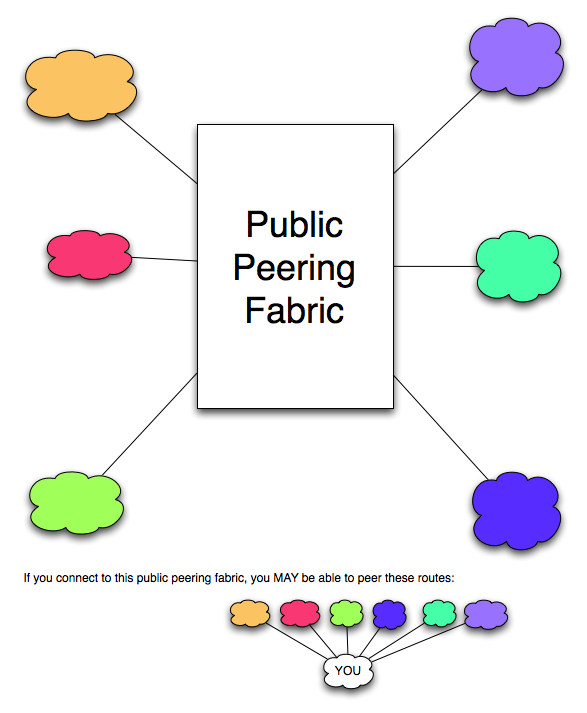
Definition: Private Peering is Internet Peering across transport with exactly two parties connected to it, usually a fiber cross connect or point to point circuit.
